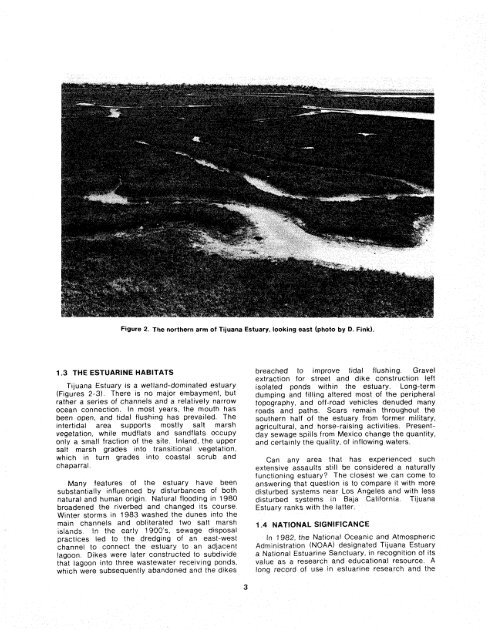The Ecology of Tijuana Estuary, California: An Estuarine Profile
The Ecology of Tijuana Estuary, California: An Estuarine Profile
The Ecology of Tijuana Estuary, California: An Estuarine Profile
Create successful ePaper yourself
Turn your PDF publications into a flip-book with our unique Google optimized e-Paper software.
-- - -- - -- -- --<br />
Figure 2. <strong>The</strong> northern arm <strong>of</strong> <strong>Tijuana</strong> <strong>Estuary</strong>, looking east (photo by O. Fink).<br />
1.3 THE ESTUARINE HABITATS<br />
<strong>Tijuana</strong> <strong>Estuary</strong> is a wetland-dominated estuary<br />
(Figures 2-31, <strong>The</strong>re is no major embayment, but<br />
rather a series <strong>of</strong> channels and a relatively narrow<br />
ocean connection. In most years, the mouth has<br />
been open, and tidal flushing has prevailed. <strong>The</strong><br />
intertidal area supports mostly salt marsh<br />
vegetation, while mudflats and sandflats occupy<br />
only a small fraction <strong>of</strong> the site. Inland, the upper<br />
salt marsh grades into transitional vegetation,<br />
which in turn grades into coastal scrub and<br />
chaparral.<br />
Many features <strong>of</strong> the estuary have been<br />
substantrally Influenced by disturbances <strong>of</strong> both<br />
natural and human origin Natural fiood~ng In 1980<br />
broadened the rrverbed and changed its course<br />
Wtnter storms in 1983 washed the dunes ~nto the<br />
marn channels and obliterated two salt marsh<br />
islands In the ear!y 1900's, sewage d~sposal<br />
practices led to the dredgrng <strong>of</strong> an east-west<br />
channel to connect the estuary to an adjacent<br />
lagoon Orkes were later constructed to subd~vrde<br />
that Lagoon tnto three wastewater receivrng ponds,<br />
which were subsec;uently abandoned and the drkes<br />
breached to rmprove trdal fltishrng Gravel<br />
extractton for street and dlke construction left<br />
rsolated ponds wrthrn the estuary. Long-term<br />
dumplng and fliling altered most <strong>of</strong> the peripheral<br />
topography, and <strong>of</strong>f-road vehlcles denuded many<br />
roads and paths Scars remain throughout the<br />
southern half <strong>of</strong> the estuary from farmer m#lltary,<br />
agricultural, and horse-rarsrng activities Presentday<br />
sewage sp~lls from Mexlco change the quantity,<br />
and certainly the quality, <strong>of</strong> lnflowlng waters.<br />
Can any area that has experrenced such<br />
extens~ve assaults stlll be considered a naturally<br />
functronlng estuary? <strong>The</strong> closest we can come to<br />
answerlng that question is to compare !t wlth more<br />
disturbed systems near Los <strong>An</strong>geles and wrth less<br />
d~slurbed systems In Baja Callfornla <strong>Tijuana</strong><br />
<strong>Estuary</strong> ranks wrth the latter<br />
In 1982, the National Oceanrc and Atmospner~c<br />
Adrnrntstrat~on (NOAA) designated Tljuana <strong>Estuary</strong><br />
a National Estuartne Sanctuary, in recognition <strong>of</strong> its<br />
value as a research and educational resource. A<br />
long record <strong>of</strong> use rn estuanne research and the

















